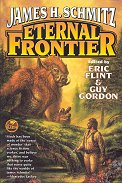Trigger Argee has been sent by her boss, Holati Tate, to Maccadon,
the University Planet, to oversee the plasmoid project. So why are neither
Tate nor Professor Mantelish anywhere to be found, and why is Trigger
being kept in the dark? And why is Pilch of the Psychology Service so keen
to look deep inside her mind? Moreover, Trigger is feeling a strong desire
to return to Manon, yet everything seems to be conspiring against letting
her leave. But Trigger is not a woman to be dictated to.
The story of how Trigger leaves Maccadon, meets up with Heslet Quillan,
and her various adventures before she finally discovers the secret of the
plasmoids, is told in Schmitz' great style. A few of the social attitudes
might seem a little dated forty years on (although actually rather ahead
of their time), but whatever the decade of reading, Trigger is one of
Schmitz' great competent heroines.
I remember finding Legacy rather confusing when I first read it,
several decades ago, but I enjoyed it thoroughly. Rereading it now as part
of the republication of the entire Hub stories, it is
less confusing -- because I know a lot of the characters already -- but
just as much fun.













